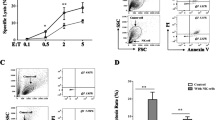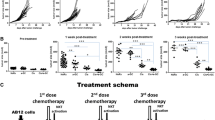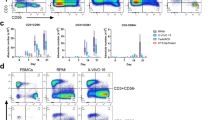Abstract
The development of resistance to anticancer drugs urges the search for different treatment modalities. Several investigators have reported the concomitant development of drug resistance and resistance to natural killer (NK), lymphokine-activated killer (LAK) or monocyte/macrophage cell lysis, while others described unchanged or even increased susceptibility. We investigated this subject in the rat colon carcinoma cell line, CC531-PAR, which is intrinsically multidrug-resistant (MDR), and in three sublines derived from this parental cell line: a cell line with an increased MDR phenotype (CC531-COL), a revertant line from CC531-COL (CC531-REV), which demonstrates enhanced sensitivity to anticancer drugs of the MDR phenotype, and an independently developed cisplatin-resistant line (CC531-CIS). In a 4-h51Cr-release assay we found no difference in susceptibility to NK cell lysis. No significant differences in lysability by adherent LAK (aLAK) cells were observed in a 4-h assay. In a prolonged 20-h51Cr-release assay an enhanced sensitivity to aLAK-cell-mediated lysis was observed in the revertant, P-glycoprotein-negative cell line and in the cisplatin-resistant cell line (CC531-CIS). None of the cell lines was completely resistant to lysis by aLAK cells. Therefore, a role for immunotherapy in the treatment of drug-resistant tumors remains a realistic option.
Similar content being viewed by others
References
Ades EW, Bosse D, Pruckler J (1990) Potentiation of human natural killer cell activity by recombinant interleukin-2 towards multidrugresistant human epidermoid carcinoma. Pathobiology 58: 84
Andrews PA, Howell SB (1990) Cellular pharmacology of cisplatin: perspectives on mechanisms of acquired resistance. Cancer Cells 2: 35
Allavena P, Grandi M, D'Incalci M, Geri O, Giuliani FC, Mantovani A (1987) Human tumor cell lines with pleiotropic drug resistance are efficiently killed by interleukin-2 activated killer cells and by activated monocytes. Int J Cancer 40: 104
Allavena P, Damia G, Colombo T, Maggioni D, D'Incalci M, Mantovani A (1989) Lymphokine-activated killer (LAK) and monocytemediated cytotoxicity on tumor cell lines resistant to antitumor agents. Cell Immunol 120: 250
Allavena P, Peccatori F, Maggioni D, Pirovano P, Mantovani A (1989) Killing of tumor cells with pleiotropic drug resistance by OK432-activated effector cells. Immunopharmacol Immunotoxicol 11: 257
Benoist H, Madoulet C, Jardillier J-C, Desplaces A (1985) Adriamycin induced resistance of sensitive K 562 cells to natural killer lymphocyte attack. Cancer Immunol Immunother 20: 122
Bolhuis RL, Sturm E, Braakman E (1991) T cell targeting in cancer therapy. Cancer Immunol Immunother 34: 1
Eggermont AMM, Marquet RL, De Bruin RWF, Jeekel J (1986) Effects of the interferon-inducer ABPP on colon cancer in rats: importance of tumor load and tumor site. Cancer Immunol Immunother 22: 217
FitzGerald DJ, Willingham MC, Cardarelli CO, Hamada H, Tsuruo T, Gottesman MM, Pastan I (1987) A monoclonal antibody-Pseudomonas toxin conjugate that specifically kills multidrug-resistant cells. Proc Natl Acad Sci USA 84: 4288
Gambacorti-Passerini C, Rivoltini L, Supino R, Mariani M, Parmiani G (1988) Differential lysis of melanoma clones by autologous recombinant interleukin 2-activated lymphocytes. Relationship with spontaneous resistance to doxorubicin (Dx). Int J Cancer 42: 544
Gambacorti-Passerini C, Rivoltini L, Supino R, Rodolfo M, Radrizzani M, Fossati G, Parmiani G (1988) Susceptibility of chemoresistant murine and human tumor cells to lysis by interleukin 2-activated lymphocytes. Cancer Res 48: 2372
Gautam SC, Chikkala NF, Lewis I, Grabowski DR, Finke JH, Ganapathi R (1992) Therapeutic efficacy of interleukin-2 activated killer cells against Adriamycin resistant mouse B16-BL6 melanoma. Anticancer Res 12: 921
Gheuens EEO, Van Bockstaele DR, Van der Keur M, Tanke HJ, Van Oosterom AT, De Bruijn EA (1991) Flow cytometric double labelling technique for screening of multidrug resistance. Cytometry 12: 636
Gheuens EEO, Van der Heyden SAM, Elst HJ, Eggermont AMM, Van Oosterom AT, De Bruijn EA (1993) Multidrug resistance in rat colon carcinoma cell lines CC531, CC531mdr+ and CC531rev, Jpn J Cancer Res (in press)
Goldstein LJ, Galski H, Fojo A, Willingham M, Lai S-L, Gazdar A, Pirker R, Green A, Crist W, Brodeut GM, Lieber M, Cossman J, Gottesman MM, Pastan I (1989) Expression of a multidrug resistance gene in human cancers. J Natl Cancer Inst 81: 116
Harker WG, Tom C, McGregor JR, Slade L, Samlowski WE (1990) Human tumor cell line resistance to chemotherapeutic agents does not predict resistance to natural killer or lymphokine-activated killer cell-mediated cytolysis. Cancer Res 50: 5931
Julius MH, Simpson E, Herzenberg LA (1973) A rapid method for the isolation of functional thymus derived murine lymphocytes. Eur J Immunol 3: 645
Kimmig A, Gekeler V, Neumann M, Frese G, Handgretinger R, Kardos G, Diddens H, Niethammer D (1990) Susceptibility of multidrug-resistant human leukemia cell lines to human interleukin 2-activated killer cells. Cancer Res 50: 6793
Los G, Nagel JD, McVie JG (1990) Anti-tumor effect of cisplatin, carboplatin, mitoxantrone, and doxorubicin on peritoneal tumor growth after intraperitoneal and intravenous chemotherapy: a comparative study. Sel Cancer Ther 6: 73
Marquet RL, Westbroek DL, Jeekel J (1984) Interferon treatment of a transplantable rat colon adenocarcinoma: importance of tumor site. Int J Cancer 33: 689
Marquet RL, IJzermans JNM, De Bruin RWF, Fiers W, Jeekel J (1987) Antitumor activity of recombinant mouse tumor necrosis factor (TNF) on colon cancer in rats is promoted by recombinant rat interferon gamma; toxicity is reduced by indomethacin. Int J Cancer 40: 550
Mickisch GH, Pai LH, Gottesman MM, Pastan I (1992) Monoclonal antibody MRK16 reverses the multidrug resistance of multidrug-resistant transgenic mice. Cancer Res 52: 4427
Mickisch GH, Pai LH, Siegmund M, Campain J, Gottesman MM, Pastan I (1993)Pseudomonas exotoxin conjugated to monoclonal antibody MRK16 specifically kills multidrug resistant cells in cultured renal carcinomas and in MDR-transgenic mice. J Urol 149: 174
Mizutani Y, Banovida B, Nio Y, Yoshida O (1993) Enhanced susceptibility ofcis-diamminedichloroplatinum-treated K562 cells to lysis by peripheral blood lymphocytes and lymphokine activated killer cells. Cancer 71: 1313
Ohtsu A, Sasaki Y, Tamura T, Fujiwara Y, Ohe Y, Minato K, Nakagawa K, Bungo M, Saijo N (1989) Inhibition of colony formation of drug-resistant human tumor cell lines by combinations of interleukin-2-activated killer cells and antitumor drugs. Jpn J Cancer Res 80: 265
Pastan I, Gottesman M (1987) Multiple-drug resistance in human cancer. N Engl J Med 316: 1388
Prehn RT, Main JW (1957) Immunity to methylcholanthrene induced sarcomas. J Natl Cancer Inst 18: 769
Pross HF, Baines MG, Rubin P, Shragge P, Patterson MS (1981) Spontaneous human lymphocyte-mediated cytotoxicity against tumor target cells. IX. The quantitation of natural killer cell activity. J Clin Immunol 1: 51
Rivoltini L, Gambacorti-Passerini C, Supino R, Parmiani G (1989) Generation and partial characterization of melanoma sublines resistant to lymphokine activated killer (LAK) cells. Relevance to doxorubicin resistance. Int J Cancer 43: 880
Rivoltini L, Colombo MP, Supino R, Ballinari D, Tsuruo T, Parmiani G (1990) Modulation of multidrug resistance by verapamil ormdrl anti-sense oligodeoxynucleotide does not change the high susceptibility to lymphokine-activated killers inmdr-resistant human carcinoma (LoVo) line. Int J Cancer 46: 727
Rivoltini L, Cattoretti G, Arienti F, Mastroianni A, Melani C, Colombo MP, Parmiani G (1991) The high lysability by LAK cells of colon-carcinoma cells resistant to doxorubicin is associated with a high expression of ICAM-1, LFA-3, NCA and a less-differentiated phenotype. Int J Cancer 47: 746
Rosenberg SA (1991) Immunotherapy and gene therapy of cancer. Cancer Res 51: 5074s
Safrit JT, Bonavida B (1992) Hierarchy of in vitro sensitivity and resistance of tumor cells to cytotoxic effector cells, cytokines, drugs and toxins. (1992) Cancer Immunol Immunother 34: 321
Savas B, Cole SPC, Akoglu TF, Pross HF (1992) P-glycoprotein-mediated multidrug resistance and cytotoxic effector cells. Nat Immun 11: 177
Scheper RJ, Dalton WS, Grogan TM, Schlosser A, Bellamy WT, Taylor CW, Scuderi P, Spier C (1991) Altered expression of P-glycoprotein and cellular adhesion molecules on human multi-drug-resistant tumor cells does not affect their susceptibility to NK- and LAK-mediated cytotoxicity. Int J Cancer 48: 562
Scheringa M, IJzermans JNM, Jeekel J, Marquet RL (1990) The antitumour activity of the interferon inducer bropirimine is partially mediated by endogenous tumour necrosis factor-α. Cancer Immunol Immunother 32: 251
Treichel RS, Olken S (1992) The relationship between multi-drug resistance and resistance to natural-killer-cell and lymphokine-activated killer-cell lysis in human leukemic cell lines. Int J Cancer 50: 305
Van de Vric W, Gheuens EEO, Durante NMC, De Bruijn EA, Marquet RL, Van Oosterom AT, Eggermont AMM (1993) In vitro and in vivo chemosensitizing effect of cyclosporin-A on an intrinsic multidrug resistant rat colon tumour. J Cancer Res Clin Oncol 119: 609
Van Dijk J, Tsuruo T, Segal DM, Bolhuis RLH, Colognola R, Van de Griend RJ, Fleuren GJ, Warnaar SO (1989) Bispecific antibodies reactive with the multidrug-resistance-related glycoprotein and CD3 induce lysis of multidrug-resistant tumor cells. Int J Cancer 44: 738
Vujanovic NL, Herberman RB, Maghazachi AA, Hiserodt JC (1988) Lymphokine-activated killer cells in rats III. A simple method for the purification of large granular lymphocytes and their rapid expansion and conversion into lymphokine-activated killer cells. J Exp Med 167: 15
Wood WJ, Lotzovà E (1989) Adriamycin-induced resistance to natural killer (NK)-mediated cytotoxicity. Cancer 64: 396
Woods G, Lund LA, Naik M, Ling V, Ochi A (1988) Resistance of multidrug-resistant lines to natural killer-like cell-mediated cytotoxicity. FASEB J 2: 2791
Yanovich S, Hall RE, Weinert C (1986) Resistance to natural killer cell-mediated cytolysis by a pleiotropic drug-resistant human erythroleukemia (K562-R) cell line. Cancer Res 46: 4511
Author information
Authors and Affiliations
Rights and permissions
About this article
Cite this article
Van de Vrie, W., Van der Heyden, S.A.M., Gheuens, E.E.O. et al. Drug resistance in rat colon cancer cell lines is associated with minor changes in susceptibility to cytotoxic cells. Cancer Immunol Immunother 37, 337–342 (1993). https://doi.org/10.1007/BF01518457
Received:
Accepted:
Issue Date:
DOI: https://doi.org/10.1007/BF01518457




